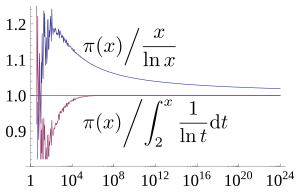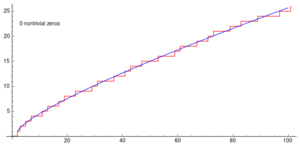Prime-counting function facts for kids
The prime-counting function is a special tool in mathematics that helps us count prime numbers. It's like a prime number counter! We write it as π(x). This function tells you how many prime numbers there are that are less than or equal to a certain number x. For example, if x is 10, the prime numbers less than or equal to 10 are 2, 3, 5, 7. So, π(10) would be 4.
It's important to remember that this π(x) has nothing to do with the famous number pi (about 3.14159...). They just happen to use the same symbol!
Contents
How Many Primes Are There?
Mathematicians are very interested in how fast the number of primes grows as x gets bigger. This is a big question in number theory.
The Prime Number Theorem
Around the late 1700s, mathematicians like Carl Friedrich Gauss and Adrien-Marie Legendre guessed that the number of primes up to x could be estimated using a simple formula: x divided by the natural logarithm of x.
This idea became known as the Prime Number Theorem. It says that as x gets really, really big, the actual number of primes, π(x), gets very close to this estimate.
In 1896, two mathematicians, Jacques Hadamard and Charles Jean de la Vallée-Poussin, independently proved this theorem. They used advanced math involving something called the Riemann zeta function. Later, around 1948, Atle Selberg and Paul Erdős found simpler ways to prove it without using those complex tools.
Better Estimates for Primes
For numbers that aren't super huge, another estimate called the logarithmic integral function (written as li(x)) is often even closer to the actual number of primes.
Mathematicians have found even more precise ways to estimate π(x). For example, for numbers x greater than 229, the difference between the actual count of primes and the li(x) estimate is very small.
Interestingly, for many values of x, li(x) is a bit larger than π(x). But it's known that this difference actually switches back and forth an infinite number of times as x gets larger!
Counting Primes: A Big Table
This table shows how the actual number of primes, π(x), compares to two different estimates: x / log x and li(x). You can see that li(x) is generally a much closer guess!
| x | π(x) | π(x) − x / log x | li(x) − π(x) | x / π(x) | x / log x % Error |
|---|---|---|---|---|---|
| 10 | 4 | 0 | 2 | 2.500 | -8.57% |
| 102 | 25 | 3 | 5 | 4.000 | 13.14% |
| 103 | 168 | 23 | 10 | 5.952 | 13.83% |
| 104 | 1,229 | 143 | 17 | 8.137 | 11.66% |
| 105 | 9,592 | 906 | 38 | 10.425 | 9.45% |
| 106 | 78,498 | 6,116 | 130 | 12.739 | 7.79% |
| 107 | 664,579 | 44,158 | 339 | 15.047 | 6.64% |
| 108 | 5,761,455 | 332,774 | 754 | 17.357 | 5.78% |
| 109 | 50,847,534 | 2,592,592 | 1,701 | 19.667 | 5.10% |
| 1010 | 455,052,511 | 20,758,029 | 3,104 | 21.975 | 4.56% |
| 1011 | 4,118,054,813 | 169,923,159 | 11,588 | 24.283 | 4.13% |
| 1012 | 37,607,912,018 | 1,416,705,193 | 38,263 | 26.590 | 3.77% |
| 1013 | 346,065,536,839 | 11,992,858,452 | 108,971 | 28.896 | 3.47% |
| 1014 | 3,204,941,750,802 | 102,838,308,636 | 314,890 | 31.202 | 3.21% |
| 1015 | 29,844,570,422,669 | 891,604,962,452 | 1,052,619 | 33.507 | 2.99% |
| 1016 | 279,238,341,033,925 | 7,804,289,844,393 | 3,214,632 | 35.812 | 2.79% |
| 1017 | 2,623,557,157,654,233 | 68,883,734,693,928 | 7,956,589 | 38.116 | 2.63% |
| 1018 | 24,739,954,287,740,860 | 612,483,070,893,536 | 21,949,555 | 40.420 | 2.48% |
| 1019 | 234,057,667,276,344,607 | 5,481,624,169,369,961 | 99,877,775 | 42.725 | 2.34% |
| 1020 | 2,220,819,602,560,918,840 | 49,347,193,044,659,702 | 222,744,644 | 45.028 | 2.22% |
| 1021 | 21,127,269,486,018,731,928 | 446,579,871,578,168,707 | 597,394,254 | 47.332 | 2.11% |
| 1022 | 201,467,286,689,315,906,290 | 4,060,704,006,019,620,994 | 1,932,355,208 | 49.636 | 2.02% |
| 1023 | 1,925,320,391,606,803,968,923 | 37,083,513,766,578,631,309 | 7,250,186,216 | 51.939 | 1.93% |
| 1024 | 18,435,599,767,349,200,867,866 | 339,996,354,713,708,049,069 | 17,146,907,278 | 54.243 | 1.84% |
| 1025 | 176,846,309,399,143,769,411,680 | 3,128,516,637,843,038,351,228 | 55,160,980,939 | 56.546 | 1.77% |
| 1026 | 1,699,246,750,872,437,141,327,603 | 28,883,358,936,853,188,823,261 | 155,891,678,121 | 58.850 | 1.70% |
| 1027 | 16,352,460,426,841,680,446,427,399 | 267,479,615,610,131,274,163,365 | 508,666,658,006 | 61.153 | 1.64% |
| 1028 | 157,589,269,275,973,410,412,739,598 | 2,484,097,167,669,186,251,622,127 | 1,427,745,660,374 | 63.456 | 1.58% |
| 1029 | 1,520,698,109,714,272,166,094,258,063 | 23,130,930,737,541,725,917,951,446 | 4,551,193,622,464 | 65.759 | 1.52% |
The numbers in this table for very large values of x (like 1024 and beyond) were found by super powerful computers and mathematicians like J. Buethe, Jens Franke, A. Jost, T. Kleinjung, D. J. Platt, D. B. Staple, David Baugh, and Kim Walisch.
How to Calculate π(x)
Finding π(x) for small numbers is easy. You can just list the primes and count them.
Using the Sieve of Eratosthenes
One simple way to find all primes up to a certain number x is to use the sieve of Eratosthenes. This method helps you find all prime numbers up to x, and then you just count how many there are.
Legendre's Method
For larger numbers, mathematicians use more clever ways. Adrien-Marie Legendre came up with a method that uses a principle called inclusion–exclusion principle. It's a bit like counting all numbers, then subtracting those divisible by primes, then adding back those divisible by two primes, and so on.
The Meissel–Lehmer Algorithm
For very, very large numbers, even more advanced methods are needed. Ernst Meissel and later Derrick Henry Lehmer developed a complex way to calculate π(x). This method involves breaking down the problem into smaller parts and using special counting functions.
Using his method, Meissel calculated π(x) for numbers up to 100 million (108). Later, Lehmer used an early computer (an IBM 701) to calculate π(109) (1 billion) correctly, and almost got π(1010) right!
Other Ways to Count Primes
Besides π(x), mathematicians use other functions that are related to prime counting. These functions are often easier to work with in advanced math.
Riemann's Prime-Power Counting Function
This function, often called  or Failed to parse (Missing <code>texvc</code> executable. Please see math/README to configure.): \ J_0(x)\ , counts not just primes, but also powers of primes (like 4 which is 22, or 8 which is 23, or 9 which is 32). It gives a smaller "jump" for prime powers.
or Failed to parse (Missing <code>texvc</code> executable. Please see math/README to configure.): \ J_0(x)\ , counts not just primes, but also powers of primes (like 4 which is 22, or 8 which is 23, or 9 which is 32). It gives a smaller "jump" for prime powers.
Chebyshev's Functions
The Chebyshev functions are another set of prime-counting functions. They are called Failed to parse (Missing <code>texvc</code> executable. Please see math/README to configure.): \ \theta(x)\ and Failed to parse (Missing <code>texvc</code> executable. Please see math/README to configure.): \ \psi(x)\ . Instead of just counting, these functions add up the natural logarithm of each prime (or prime power). They are very useful in proving theorems about primes.
Formulas for Prime-Counting Functions
Mathematicians have found amazing formulas that can describe these prime-counting functions. These formulas come in two main types:
- Arithmetic formulas: These are based on counting properties of numbers.
- Analytic formulas: These use tools from calculus and complex analysis.
The analytic formulas were key to proving the Prime Number Theorem. They connect the distribution of primes to the special properties of the Riemann zeta function.
One famous formula for the Chebyshev function Failed to parse (Missing <code>texvc</code> executable. Please see math/README to configure.): \psi_0(x) involves summing over the "zeros" of the Riemann zeta function. These "zeros" are special points where the zeta function equals zero.
There's also a complex formula for  that uses the logarithmic integral function and also sums over these zeta function zeros. These formulas show how deeply connected prime numbers are to other areas of mathematics.
that uses the logarithmic integral function and also sums over these zeta function zeros. These formulas show how deeply connected prime numbers are to other areas of mathematics.
Prime Number Rules
Mathematicians have also found some useful rules, called inequalities, that give us upper and lower limits for π(x). These rules help us know that π(x) will always be between certain values.
For example, for numbers x 17 or larger, we know that:  This means the actual number of primes is always between these two estimates.
This means the actual number of primes is always between these two estimates.
There are also inequalities for the nth prime number, written as pn. These help us estimate the size of the 10th, 100th, or even billionth prime number!
The Riemann Hypothesis
The Riemann hypothesis is one of the biggest unsolved problems in mathematics. If it turns out to be true, it would mean that our estimates for π(x) are even more accurate than we currently know.
It would imply a much tighter boundary on the error in estimating π(x). This would mean that prime numbers are distributed even more regularly and predictably than we currently understand.
See also
 In Spanish: Función contador de números primos para niños
In Spanish: Función contador de números primos para niños
- Foias constant
- Bertrand's postulate
- Oppermann's conjecture
- Ramanujan prime




